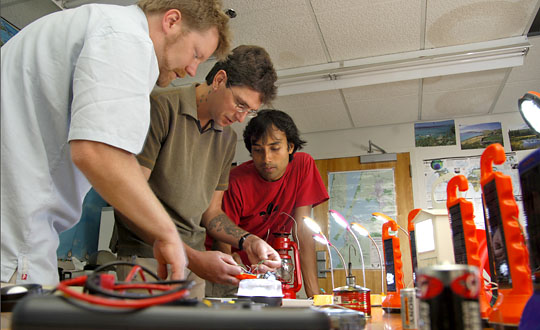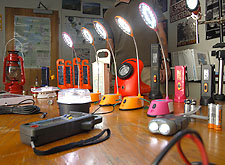
Arne Jacobson holds up a small kerosene lamp used by Kenyan schoolchildren to do homework at night.
Made from a soup can, the device emits a smoky, flickering flame and noxious fumes when lit. Jacobson collected the lamp during one of his more than a dozen trips to Kenya. “I get a headache whenever I use one,” says the Humboldt State assistant professor of environmental resources engineering. “So you can imagine what it’s like for a child trying to do schoolwork. They complain about feeling dizzy and sick.”
Americans take lighting for granted. Flick a switch and night turns to day. But for rural Kenyans and an estimated 1.6 billion people worldwide who live in areas with no electrical grid, creating light means igniting a kerosene or fuel lamp. This fuel-based lighting harms the environment and human health, stifles education and economic development. It is also expensive, costing $40 billion worldwide.
Jacobson is working on a solution. His Off-Grid Lighting project is helping to develop clean, efficient and affordable lights suitable for Kenya and other impoverished regions of the globe. White light-emitting diodes, known as WLEDs or LEDs, hold the most promise. Used on headlamps and bicycles in the United States, WLEDs are ideal for the developing world because they are portable, bright and run on batteries—ideal for off-grid locations. When charged by solar power, a plentiful resource in sub-Saharan Africa, they emit no pollution or greenhouse gases.

Jacobson, a participant in HSU’s Schatz Energy Research Center, spent much of last summer in Kenya, where he evaluated WLED devices with children, teachers, parents and night-market street vendors. He heard stories of children unable to study because their families ran out of kerosene. Some Kenyans teased him, saying that he should stop researching the lights and start selling them. But Jacobson’s role is quality assurance. “We’re sort of like Consumer Reports.”
In his campus office, Jacobson and four researchers (graduate students Stephen Kullmann, Ranjit Deshmukh and Kristen Radecsky, and undergraduate Kyle Palmer) test the longevity and durability of WLED lamps available in Kenya. “We figure out which products are good and which are bad, and we send our information to the manufacturers,” Jacobson says. It’s important work. There are no consumer protection laws in Kenya, and people who buy poorly designed products are stuck.
Jacobson lifts a solar-powered flashlight. The U.S.-based designer is remaking the light to address flaws discovered by Jacobson and his team. Mark Bent, CEO of Sun Night Solar, which makes the product, calls Jacobson an “invaluable” resource. “I always like Arne’s reports, read them, use them, share them with my factory design engineers and find them of great value.”
Hoping that a Kenyan university will take over this product evaluation, Jacobson designed the testing protocols so they can be easily replicated with simple equipment. “Arne is a real treasure for HSU,” says Evan Mills, an energy efficiency researcher at Lawrence Berkeley National Laboratory who traveled with Jacobson in Kenya last summer. “He has a great grasp of the social and technical and economic issues of efficient lighting.”
Jacobson is now providing advice about Kenya’s lighting needs to a groundbreaking venture: Lighting Africa, a World Bank-financed project to bring off-the-grid lights to 250 million impoverished Africans. It is a project with global environmental significance. Fuel-based lighting worldwide emits 200 million tons of greenhouse gases per year—the equivalent of about 30 million U.S. cars.
For Jacobson, providing efficient light to the poor is a humanitarian issue. While lighting costs Americans a tiny fraction of their income, people in the developing world often spend 10 percent of their money on kerosene and other fuels for illumination. Worse yet, Jacobson says, these people get little bang for their lighting buck. Fuel lamps account for 17 percent of global lighting costs, but because of their inefficiency they provide less than one-tenth of one percent of global light output. “The poorest people,” Jacobson says, “pay the most per unit of light.”
Jacobson first visited Kenya in 1999 while a doctoral student at Berkeley. “I was interested in studying solar technologies in a place where it was being used widely.” Kenya was ideal. Per capita, the country has one of the world’s highest rates of solar power use. More than 200,000 Kenyan households have solar systems, albeit small ones costing about $200. The reason is simple: Kenyans want their MTV. “Television drives the solar market in rural Kenya,” Jacobson says. Solar panels charge car batteries that power small black and white TV sets.
Jacobson has a deep affection for Kenya, where he is well-known among electricians and rural solar system installers because of his column, “AJ’s Technical Tips,” that runs in an African renewable energy magazine. Jacobson took a job at HSU in 2004 because he wanted to work at a school with a “hands-on renewable energy dimension. HSU is one of the best programs in the country for that.”
Now he is using that hands-on approach to help some of the planet’s poorest people. Westerners have an obligation to provide clean and efficient light and power to the world’s poor, he says. “We have to find solutions that help them move forward. This work is a small part of the solution.”